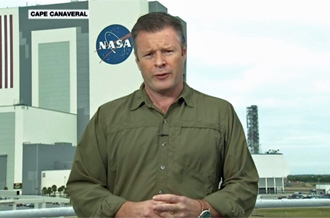Orion spacecraft completes successful voyage
Unmanned NASA mission seen as major step towards deep space exploration that could put people on Mars one day.

NASA’s new Orion spacecraft has landed in the Pacific Ocean following a successful test flight that took it to a height of 5,800km.
Friday’s unmanned flight ended after four and a half hours and achieved at least one record: flying farther and faster than any capsule built for humans since the Apollo moon programme.
“There’s your new spacecraft, America,” Rob Navias, Mission Control commentator at the Kennedy Space Centre in Cape Canaveral, said as the Orion capsule neared the water 435km off Mexico’s Baja peninsula.
Navias called the journey “the most perfect flight you could ever imagine”.
Mike Sarafin, the lead flight director, spoke emotionally as he signed off from Houston.
Keep reading
list of 4 itemsHong Kong’s first monkey virus case – what do we know about the B virus?
Why will low birthrate in Europe trigger ‘Staggering social change’?
The Max Planck Society must end its unconditional support for Israel
“We challenged our best and brightest to continue to lead in space,” he said.
| Notes from the field |
|
Andy Gallacher in Cape Canaveral: Engineers here say it was a textbook start for the unmanned mission that, it is hoped, will eventually take humans into deep space. The causeways and highways around the Kennedy Space Center were lined with onlookers keen to see history in the making, and you could hear a cheer go up at the Kennedy Space Center as Orion finally lifted off. This is the start of a long process for the Orion programme. It will be years before humans climb aboard to venture into deep space, but NASA says we are now one step closer to a new frontier and exciting discoveries ahead.
|
“While this was an unmanned mission, we were all on board Orion.”
The successful mission was the first time in 42 years that NASA sent a spacecraft built for humans farther than a couple hundred miles from Earth.
The previous time was the Apollo 17 moonshot.
“Very exciting,” Mark Geyer, NASA’s Orion programme manager, said early in the flight.
“We still have a bunch to go.”
NASA is now “one step closer” to putting humans aboard Orion, Charles Bolden Jr, NASA Administrator, said.
He called it “Day One of the Mars era”.
NASA had initially postponed the launch of the unmanned spacecraft earlier on Friday.
Al Jazeera’s Andy Gallacher, reporting from the Kennedy Space Centre, said the delay was more of a frustrating start to Orion’s historic launch than a disappointment.
“Technical issues, high winds and stray boats aside safety is a top proirity for the space agency and there is still a 25-day launch window for NASA’s best new hope,” he said.
He said that at the Kennedy Space Centre there was “a palpable sense of anticipation for what Orion could achieve and a sense that pride is back in the US space programme”.
The conical spacecraft looks similar to the Apollo capsule that took astronauts to the Moon in the 1960s and 1970s, but slightly larger and with modern electronics.
NASA is counting on future Orions to carry astronauts beyond Earth’s orbit, to an asteroid trapped in lunar orbit in the 2020s and to Mars in the 2030s.
NASA said it wanted to experiment with the capsule’s most critical parts before it carried astronauts.
This $370m trial included the heat shield, parachutes and all the sections jettisoned during ascent and entry.
The capsule was designed to pass through extreme radiation in the Van Allen belts surrounding Earth, as engineers wanted to estimate the effects on the onboard computers.
